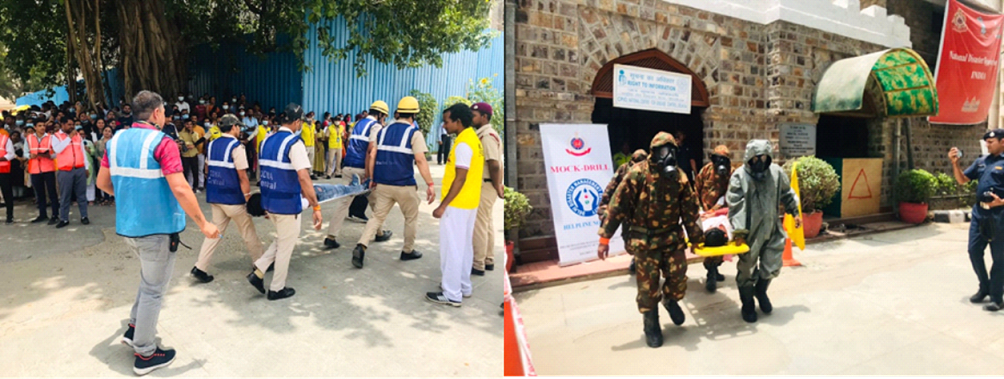A multi-hazard mock drill involving an earthquake of severe intensity leading to fires and a chemical leakage was conducted at the National Centre for Disease Control (NCDC) campus in Delhi on 7 June 2022 in coordination with the National Disaster Response Force (NDRF) and with technical support from WHO India. The goal was to test how plans are better implemented during events. The aim was to enhance future coordination, synergize efforts of various emergency agencies, and find gaps in systems while responding to fires, earthquake and chemical emergencies.
The drill drew attention to the need for an updated institutional Disaster Management Plan for NCDC integrating all aspects of preparedness and response strategies to various threats and hazards. NCDC drafted a Disaster Management Plan with technical support from WHO.
The NDRF has been mandated to carry out mock drills at 75 sites of national heritage across the country under the Azadi ka Amrit Mahotsav celebrations with a goal to establish the roles and responsibilities of the concerned stakeholders in ensuring key institutions continue to deliver uninterrupted services during an emergency.
The NCDC campus was identified as one of the sites because it sits in a heritage site*. Moreover. it is an institution of national importance for public health, disease surveillance, laboratories, and health research and should be preserved in any event. NCDC also hosts the Public Health Emergency Operations Centre, which is the national emergency hub to respond to public health emergencies.

Multi-hazard mock drill at NCDC (Photo: Saurabh Dalal/© WHO India)
This was the first-of-its-kind drill in the NCDC campus for some time. The stakeholders included the district administration, fire services, police department, traffic police, district disaster management authority, civil defence, Centralised Accident and Trauma Services, hospitals, and health department, 8th battalion of NDRF, WHO Country Office for India, and NCDC.
The drill included the initiation of a house response mechanism; activation of the institutional disaster management plan, incident response system and emergency operation centre at the district level; evacuation; and mass casualty management, including triage, decontamination of victims and shifting them to designated hospitals.
Following the drill, NCDC drafted an institution-specific Disaster Management Plan with technical support from WHO to complement preparedness, structural and non-structural mitigation, response, evacuation and recovery planning through the formation of a central disaster management committee for effective response to hazardous events. The plan strategically focuses on both functionality and continuation of services to deal effectively with public health emergencies and disasters. A Risk Reduction Handbook to complement the short-, medium- and long-term measures to enhance resilience at NCDC has also been completed.
“WHO is committed to strengthening systems for disaster risk reduction and emergency preparedness, devising sustainable disaster risk-communication strategies, focusing efforts to reach the high-risk communities, and supporting the development of national policies for early warning and early action. All these need to come together to reach everyone and leave no one behind,” said Dr Roderico H. Ofrin, WHO Representative to India.
*The NCDC campus includes the former official residence of the Commander-in-Chief of the Indian Army.
